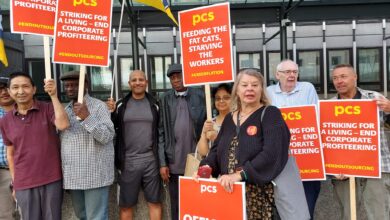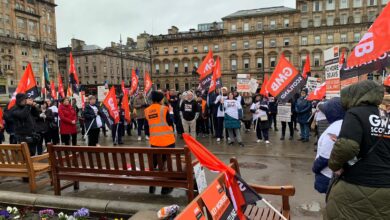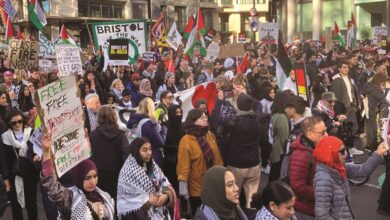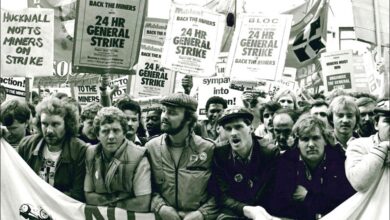The 1984/85 miners strike was a civil war without the guns
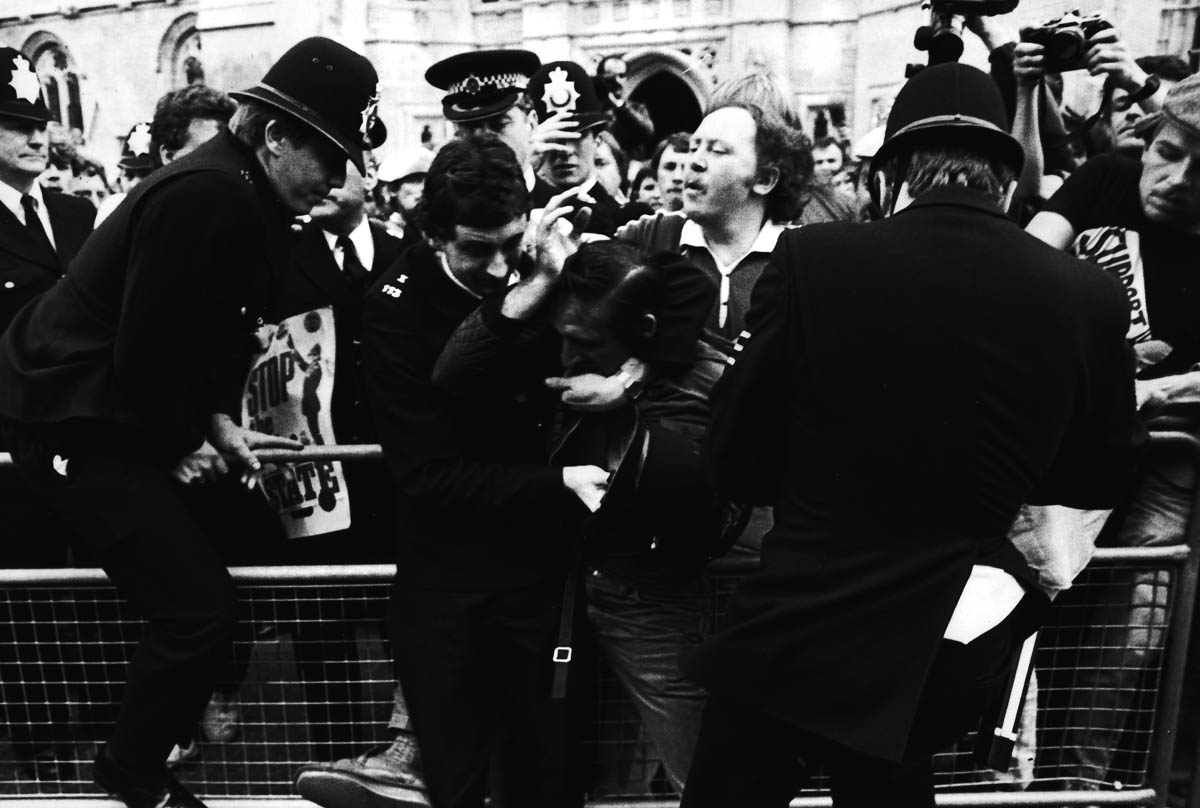
The miner’s strike of 1984/5 has correctly been described as a civil war without guns. That description may be too kind to the ruling class as they did consider using the army, as can be seen from the latest government papers released from the National Archives.
The strike lasted about a year and its legacy lives on, even after 30 years, in the communities and in the minds of those who lived through it.
The National Coal Board (NCB) had announced the need for pit closures in 1983. The National Union of Mineworkers (NUM) imposed an overtime ban. Ian McGregor, the NCB boss, announced that the plan was to close 20 pits and do away with 25.000 jobs – a lie desperately repeated by the NCB and the Tory government and supported by the media and right wing in the labour movement to undermine the miners’ struggle.
That lie has also been exposed by the release of the National Archive papers, which clarify that the real plan was to close 75 pits and axe more than 60,000 jobs.
So the miners, “the enemy within” as Margaret Thatcher, the Prime Minister at the time, described them were not lying when they claimed the real plan was to close many more pits. It was this fear of the destruction of the mining industry and the mining communities that prompted the strong reaction to the accelerated closure of Cortonwood and Bulcliffe Wood in Yorkshire. The strike movement of the Yorkshire miners spread to all areas of the British coalfield during March 1984.
The National Union of Mineworkers’ (NUM’s) federal structure left the decision making to each area, but one by one they decided to strike as the full implications of the Coal Boards intentions became clear. The NUM special delegate conference on April 1984 decided to support the action in all the coalfields. A resolution for a national ballot was overwhelmingly rejected.
Well-attended pithead meetings and ballots (in some cases) made the decisions to strike and mandate the delegates, so democracy ruled the day.
There are many aspects of the strike, which are rich in lessons for the working class in its coming struggles to change the way we live. The strike built slowly at first but soon the whole of the British coalfield was on strike, except the Nottinghamshire coalfield.
Coal reserves soon dwindled. The miners repeated the tactics of the 70’s strikes of flying pickets to travel around the country to persuade those not joining the strike to come out, or persuade those thinking of going back to work to stay out.
Mass picketing was an important element of the strike. Some miners and their supporters believed that it alone would win the dispute.
They were recalling the success of the flying pickets and the significance of the closure of the Saltley depot in Birmingham in 1972. The fact that there was almost a general strike of the engineering workers in Birmingham on that day was perhaps at least as significant factor in the closure. Nevertheless the closure of Saltley was a key turning point in the victorious outcome of that strike.
This time the situation was different. The Tories and the police in particular were determined that the sort of mass picketing would never succeed again. Orgreave coking plant saw a major trial of strength in June 1984.
Up to 10,000 miners were assembled. There were over 4000 police in riot gear with hundreds on horses ready to do battle and, from their point of view, a battle it was. Truncheons were drawn right away and after the ‘cavalry’ charge, in which hundreds of miners were batoned down, the ‘cavalry’ were applauded by the beating of riot shields with batons before the rest of the police were dispatched to break up the picket through sheer brute force. As we now know the army were on standby as well and they would have been be armed whether the intention was to use guns or not.
brutality of the state
Soon, up and down the country, police rigged out in full riot gear were brought to the picket lines at pits and anywhere miners gathered. The full naked brute force of the state was brought to bear on the miners. Police vans, buses carrying scabs and scab lorries were all kitted out with metal visors and blacked out windows. Miners in cars were regularly stopped by police whilst lorries driven by scab drivers were allowed wherever they liked to get the coal to the power stations and steel plants. Driving the wrong way round roundabouts and travelling at excess speeds on the wrong side of the road became the norm for the “Yuill and Dodd’s” lorries, which careered around the country roads of the West of Scotland.
The courts were used to criminalise miners caught up on the picket lines and many miners were then never allowed to work for the NCB again. This was indeed a war without bullets but using everything else the state had in its arsenal.
The denial of benefits led to the mining communities trying to ensure that no mineworker or his/her family were starved back to work.
solidarity
Soup kitchens were set up to share food and feed the families as cheaply as possible. Money was raised through mineworkers travelling to the non-mining communities to collect money on the streets and food outside supermarkets. The working class gave generously with donations of money, food, clothes, toys etc. Many miners support groups were set-up to assist with the strikers efforts to get donations and publicise their just cause with stalls, street meetings, public meetings and workplace visits.
In Glasgow many collections were held at football matches where the support of the public resulted in large amounts being raised in support of the miners. At some of the bigger games around Hampden Park the tenements rocked to the sound of thousands chanting slogans in support of the miners.
women
This type of activity led directly to the formation of Women’s Support groups which involved miner’s partners in the strike. Many women who had not been used to attending meetings and public speaking demonstrated their ready aptitude for the tasks of sustaining the strike, travelling throughout Britain and beyond to seek support for the fight of their communities for their survival.
As the strike unfolded it became clear that the Tory government had prepared for this confrontation and were determined to crush the miners and not allow them the victories they had won in earlier disputes. There was to be no repeat of the Miners’ victory over Ted Heath, a previous Tory Prime Minister.
It has already been well documented that the Tories had plans to take on and defeat the miners, particularly through stockpiling large stocks of coal at pits, the power stations and the steel works, huge users of Britain’s coal.
They also prepared an alternative system of transporting the coal through building up strategic haulage firms to cut across any rail workers actions to stop the transport of coal by rail. The latest release of National Archives papers expands on this by showing that the NCB chairman MacGregor and Thatcher were colluding with senior politicians from all sides, civil servants, right-wing union leaders and media bosses to demonise the miners and win the dispute.
Against this background it became clear that support from the rest of the labour and trade union movement was necessary to defeat such a determined employer supported by the state apparatus.
24-hour general strike
Militant, the predecessor of Socialist Party Scotland, raised the demand for a 24-hour general strike in support of the miners. The threatened action by the Nacods pit deputies and the dockers were, as Thatcher admitted, the two occasions when the government believed it could lose the strike.
Undoubtedly, a mass solidarity strike of other workers in support of the miners would have defeated the government.
Such wholehearted support was not there from the many of the leaders of the trade unions and the Labour Party. They used every excuse in the book to stop proper solidarity industrial action or expressing support.
One issue was the absence of a ballot. There was no ballot when 90% of the workforce was out on strike.
A ballot could have cut across this and would have been won with a strong campaign from the miners’ leaders, but the fact that the vast majority were on strike was conveniently brushed over by the faint hearts.
Another excuse used by some trade union leaders was the need to preserve the steel works by allowing enough coal to keep the ovens warm and avoid them being permanently damaged. This allowance was abused and the scab lorries were used to supplement the agreed coal being brought in my train.
The violence of the miners strike was also used – conveniently forgetting that the violence in the strike was that perpetrated by the ‘armed’ police at the picket lines and in the mining villages throughout Britain.
The 1984/5 strike became a litmus test of those who really wanted to change the way we live.
Unfortunately the majority of the trade union and labour leaders were found to be as wanting as the rank and file of the working class were found to be willing to fight.
The gradual drift back to work and the ultimate defeat of the miners cowed the working class for some time, but inevitably militancy arose again.
A new generation today will take on board the lessons of 1984/5, central to which is the need for unified action by the working class as a whole, and will seize the chance to change the way we live.
Out soon, A civil war without guns by Ken Smith
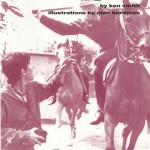
The Socialist Party’s history of the 1984-85 miners’ strike, A Civil War Without Guns, by Ken Smith, is being reprinted with a new introduction in time for the 30th anniversary of this colossal struggle. Watch this space for more details.
Available from
Socialist Books
PO Box 24697, London E11 1YD
020 8988 8789
bookshop@socialistparty.org.uk
Please make cheques payable to Socialist Books
